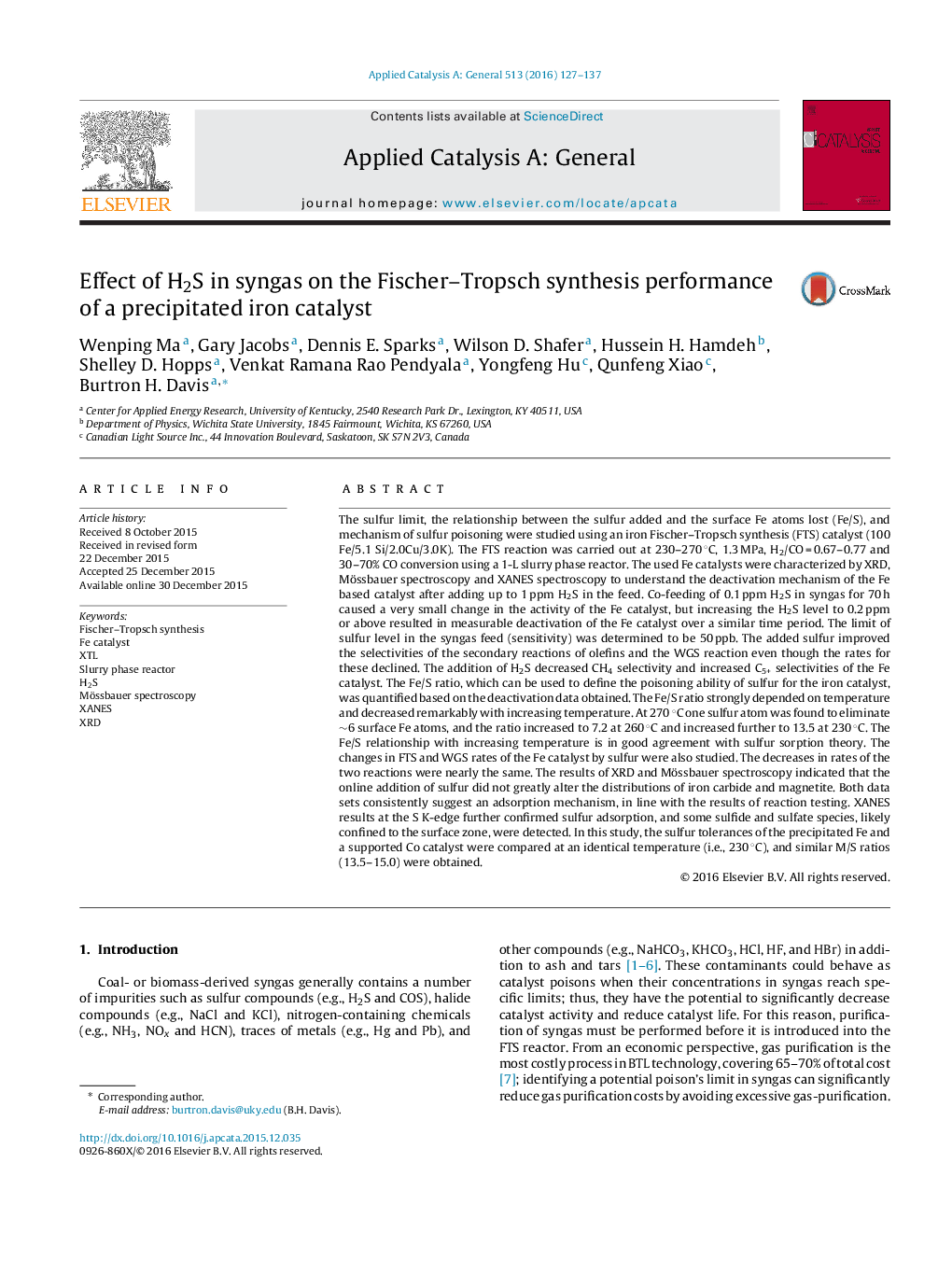| کد مقاله | کد نشریه | سال انتشار | مقاله انگلیسی | نسخه تمام متن |
|---|---|---|---|---|
| 38852 | 45793 | 2016 | 11 صفحه PDF | دانلود رایگان |

• The limit/sensitivity of an Fe–K catalyst to H2S was determined to be 50 ppb.
• H2S poisoning of the Fe–K catalyst was defined by Fe/S ratio.
• Fe/S ratios between 230 and 270 °C were determined to be 13.5 and 6.0.
• Mössbauer data showed little change in iron phase distribution by H2S (sorption).
• The ability of H2S to poison the Fe and Co catalysts was similar.
The sulfur limit, the relationship between the sulfur added and the surface Fe atoms lost (Fe/S), and mechanism of sulfur poisoning were studied using an iron Fischer–Tropsch synthesis (FTS) catalyst (100 Fe/5.1 Si/2.0Cu/3.0K). The FTS reaction was carried out at 230–270 °C, 1.3 MPa, H2/CO = 0.67–0.77 and 30–70% CO conversion using a 1-L slurry phase reactor. The used Fe catalysts were characterized by XRD, Mössbauer spectroscopy and XANES spectroscopy to understand the deactivation mechanism of the Fe based catalyst after adding up to 1 ppm H2S in the feed. Co-feeding of 0.1 ppm H2S in syngas for 70 h caused a very small change in the activity of the Fe catalyst, but increasing the H2S level to 0.2 ppm or above resulted in measurable deactivation of the Fe catalyst over a similar time period. The limit of sulfur level in the syngas feed (sensitivity) was determined to be 50 ppb. The added sulfur improved the selectivities of the secondary reactions of olefins and the WGS reaction even though the rates for these declined. The addition of H2S decreased CH4 selectivity and increased C5+ selectivities of the Fe catalyst. The Fe/S ratio, which can be used to define the poisoning ability of sulfur for the iron catalyst, was quantified based on the deactivation data obtained. The Fe/S ratio strongly depended on temperature and decreased remarkably with increasing temperature. At 270 °C one sulfur atom was found to eliminate ∼6 surface Fe atoms, and the ratio increased to 7.2 at 260 °C and increased further to 13.5 at 230 °C. The Fe/S relationship with increasing temperature is in good agreement with sulfur sorption theory. The changes in FTS and WGS rates of the Fe catalyst by sulfur were also studied. The decreases in rates of the two reactions were nearly the same. The results of XRD and Mössbauer spectroscopy indicated that the online addition of sulfur did not greatly alter the distributions of iron carbide and magnetite. Both data sets consistently suggest an adsorption mechanism, in line with the results of reaction testing. XANES results at the S K-edge further confirmed sulfur adsorption, and some sulfide and sulfate species, likely confined to the surface zone, were detected. In this study, the sulfur tolerances of the precipitated Fe and a supported Co catalyst were compared at an identical temperature (i.e., 230 °C), and similar M/S ratios (13.5–15.0) were obtained.
Figure optionsDownload high-quality image (227 K)Download as PowerPoint slide
Journal: Applied Catalysis A: General - Volume 513, 5 March 2016, Pages 127–137